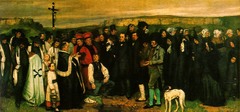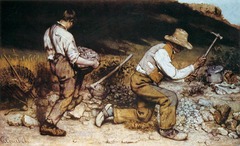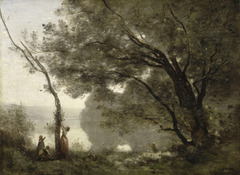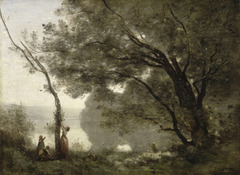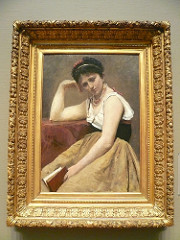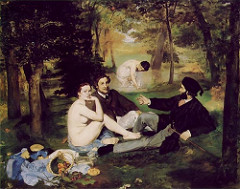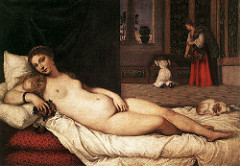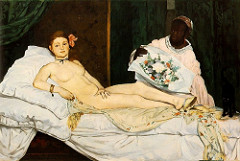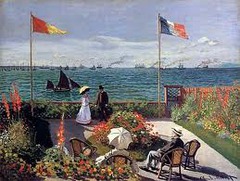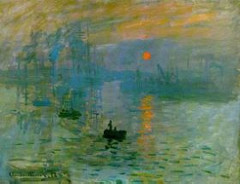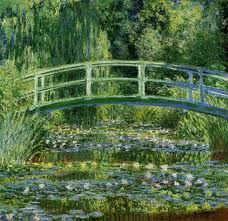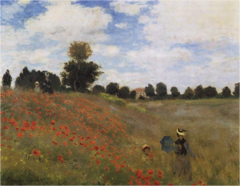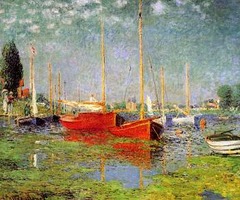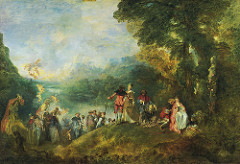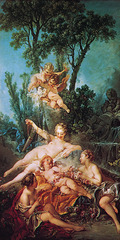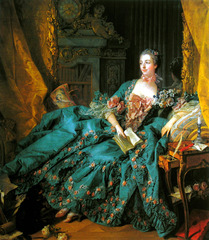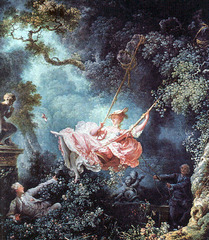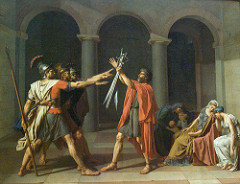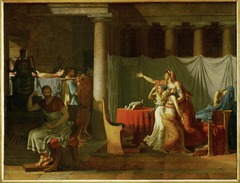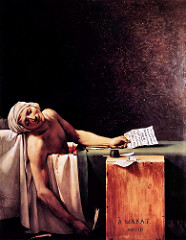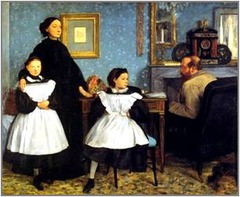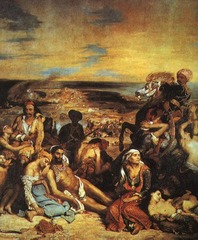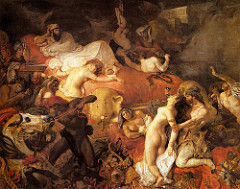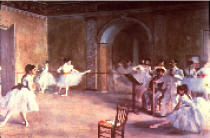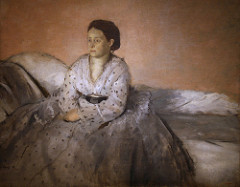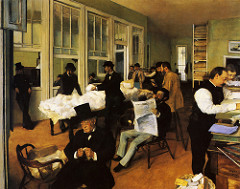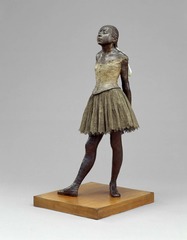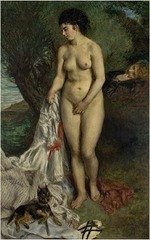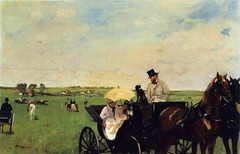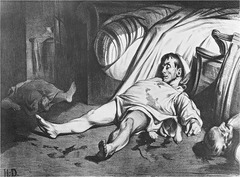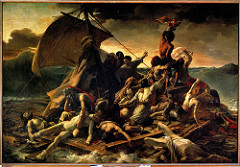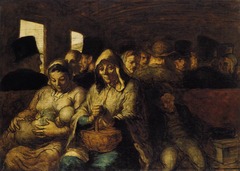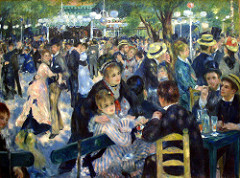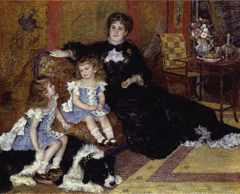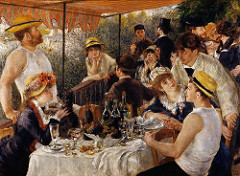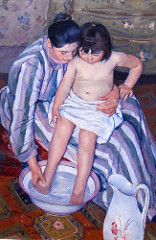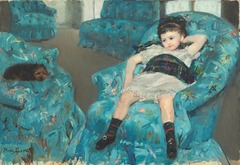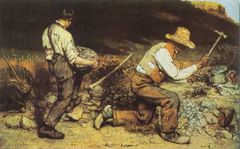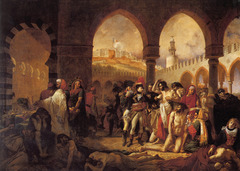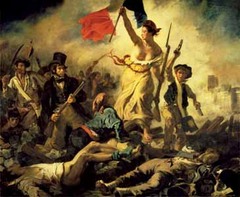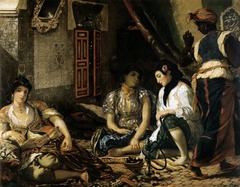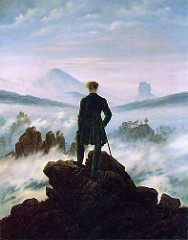Burial at Ornans by Gustave Courbet; 1849; Realism; rejected from Grande Salon; Created a lot of controversy due to the size (because big paintings depicted mythology, religion, or history) and he wouldn't answer any questions about the painting, Dog- whose dog is this? Ordinary person's funeral, We expect the clergy to try and comfort the family and to show respect and do the holy process, clergy seems nonchalant, uninterested distant, passive, It's their job; they're disengagement is shown because they aren't paying attention, the alter boys (one is looking away form the casket and having a conversation), and the guy with the crucifix is disengaged, The clergy is just as human and equal as normal people; They have the same flaws; He is not condemning the clergy
The Stonebreakers by Gustave Courbet; 1851; Realism; before the 1850's there was no such thing as oil paint in tube, before oil paint in the tube was mass produced and before that, artists were tied down to painting in the studio, oil paint in tubes= ability for artists to work outside in different lighting than studio, trying to capture the moment becomes a really big deal (the feeling of naturalism and spontaneity), he's trying to show us that he can capture naturalness
Souvenir du nord by Jean-Baptist Camille Corot; 1860; Realism; Musee d'Orsay; Monarchy and nobles bought paintings in past to be put in their chateaus to show their status, Smaller art now being purchased by Bourgeois to fill their homes, which are smaller that chateaus (now live in town homes and apartments), Smaller canvas also because of painting environment (outside), You feel he has been integrated into the setting, He is not mixing the paint on the palette; he immediately applies the blob of paint to the canvas
Souvenir de mortefontaine by Jean-Baptist Camille Corot; 1864; Realism; dabs of white creates illusion of movement/ natural setting before industrialization, sense of quietness, unrushed quality that's reassuring to us of a simpler time before industrialization, Bourgeoisie wants to assume that these people live in the city& travel here on the weekend (idealized lifestyle)
Interrupted Reading by Jean-Baptiste Camille Corot; 1870; Realism; flash of light=influence of photography (industrialization), un-posed feeling, capturing the moment, direct influence of industrialization: dull, monochromatic, un-posed, indirect: background out of focus, flatness (arms have no shadow showing spatial depth), no space between arm and clothing so her body looks compressed
Le Dejeuner sur L'Herbe by Edouard Manet; 1863; Naturalism; Musee d'Orsay; French people were accustomed to seeing naked women in paintings as goddesses or exotic women. This naked woman is very casual like she could be your sister or something, controversy was created because of the subject (naked, casual woman), flatness (flash of light/ photography influence), unfinished and experimental look. Woman is not confrontational, but seems to be challenging the audience to react
Venus of Urbino by Titian; 1538;The Venus stares straight at the viewer, unconcerned with her nudity. In her right hand she holds a posy of roses whilst she holds her other hand over her genitals. In the near background is a dog, often a symbol of fidelity, The maids in the background are shown rummaging through a similar chest, apparently in search of Venus's clothes. Curiously, given its overtly erotic content, the painting was intended as an instructive "model" for Giulia Varano, the Duke's extremely young bride, it inspired Olympia
Olympia, by Edouard Manet 1863, Musee d'Orsay, Realism, 1.) Photography = flash of light affect gives Olympia a glow and no detailed shadow. 2.) Color = gives a glowing affect and a direct look to the body of Olympia til viewers eyes focus on the painting we notice her co-worker in the background as well as the green curtains. 3.) Leading Line = the leading line starting at the top of the painting not only leading us to Olympia herself, but it also splits the two colors brown and green.
Terrace at Sainte-Adresse, Claude Monet, 1867, The Metropolitan Museum of Art, Impressionism, 1.) Flat = japonisme and photography influence the flatness of the painting. 2.) Color = All of the diverse and varying colors cause viewers not to focus on just one aspect of the painting, but always keep our eyes moving because there is so much to look at. 3.) Leading Lines = The two lines parallel to each other holding up the flags causes viewers eyes to focus on what is in-between the two flag poles, and that is the people looking out at the view as well as the boats displaying leisure time and the ships displaying the industrial revolution.
Impression Sunrise, Claude Monet, 1872, Musée Marmottan Monet, Paris, Impressionism, 1.) Diagonal = at first the painting is flat, but the use of the diagonal creates an image of depth. Not a lot of perspective. 2.) Color = gives an idea of what was going on at the time. Pollution was very bad back then, bright sky possibly because of acid rain. 3.) Dot = the Sun in the background causes viewers to look past the foreground of ships and see past them and see the industrialization going on in the background.
Bridge Over Pond of Water lillies, Claude Monet, 1899, Philadelphia Museum of Art, Impressionism, 1.) Color = the color of both the foliage and the bridge itself causes viewers to fully immerse themselves into the painting because there is so much of one color going on it feels as if we are actually there with Monet. 2.) Brushstroke = with Japanese motifs and impressionism Monet helps viewers to understand a hybrid of the two themes and understand the primacy of nature. 3.) Repetition = the repeating patches of the flowers in various spots starting from the foreground of the painting and leading us to the background of the painting allowing viewers to get a full perspective of the painting and lead up to the over arching bridge at the top of the painting.
Red poppies at Argenteuil, Claude Monet, 1873, Musee d'Orsay, impressionism, 1.) Color = the coloring of the people is similar to the color of the background. The artist embeds the humans in the back so initially we do not recognize them. 2.) Diagonal = gives the impression of the hill with the flowers. 3.) Space = Monet leaves space with placement of red dots to give a rolling affect. The flowers and the grass become more distinct as we get closer to it. Illusion with the suspension of flowers.
Woman in the Garden, Springtime, Claude Monet, 1872, The Walters Art Museum, Baltimore, impressionism, 1.) Color = The dabs of sunlight shown peaking through the trees, the unblended dabs of paint depict filtered sunlight. 2.) Focus = the woman's face and form are in clear focus which depict her as older and possibly more sophisticated. 3.) Overlap = The two colors mainly green and white depict to the viewer that the woman is almost being enveloped in this patch of green and that she is ultimately surrounded and that because she is wearing white it shows that she is wealthy and is capable of getting things dirty because they are easily replaceable.
Red Boats, Argenteuil, Claude Monet, 1875, Fogg Art Museum, Cambridge, Massachusetts, impressionism, 1.) Motif - Man with Nature = very involved, Bourgeoise want to be with nature. 2.) Color = The Red Boat serves as anchor to the painting so that viewers eyes do not stray from what is right in front of them. 3.) Truncated Image = creating an illusion that there is more to the painting, builders kept the trees to try and maintain a more natural appearance to the up and coming modern society.
Return From Cythera, Jean-Antoine Watteau, 1717, The Louvre
Style: Rococo
This painting depicts a group of people returning from the mythical island of Cythera. This painting portrays love. Cythera is the birthplace of the Greek god Venus which is the goddess of love. Everybody in this painting is touching each other and moves in a line which is a reflection of Rococo. There are many interactions between men and women in this painting which shows love. There is the couple on the right who are holding each other, the couple dancing, and another couple talking. At the bottom of the hill there are many other couples that are getting ready to get on the boat. It is unclear whether or not they are leaving Cythera. There is a statue of Venus in this painting which also portrays love. The light wispy brushstrokes and hazy landscape makes it hard to tell what time of day it is.
Cupid a Captive, Francois Boucher, 1754
Style:Rococo
This portrait is an oil on canvas. Boucher achieved success due to his graceful painting of spiritual symbols and figures in narrow valleys covered in pink and sky-blue light. The infant, cupid, and the females create the shape of a pyramid on a cool, leafy background covered with draperies. The draperies covers and reveals the nudity of the cupid and the female figures. This piece was created by a mixture of Italian and French Baroque devices such as crisscrossing diagonals, curvilinear lines, and recessions. Boucher portrays sensuality and playfulness at the same time. It is a vibrant and jovial Rococo painting style, which uses pastel colors.
Portrait of Madame de Pompadour, Francois Boucher, 1756
Style: Rococo
This is an oil on canvas painting by Boucher. This painting depicts madame de pompadour posing in an elegant room. Madame de Pompadour was a mistress of King Louis XV and was a very big patron of Boucher. Madame de Pompadour was a larger presence in the court than other mistresses because she had a cordial relationship with the queen. In the painting Madame De Pompadour is reading a book which shows that this woman is actually intelligent and not just a regular woman. She is dressed in an elegant blue dress that is obviously a very expensive which indicates that she is a person of wealth. She is covered in flowers and there are flowers at her feet which make her a symbol of desire like many Rococo paintings. The room she is in is very elaborate. This painting was for her to show the king her love and desire.
The Swing, Jean-Honore Fragonard, 1767
Style: Rococo
This picture became an immediate success, not merely for its technical excellence, but for the scandal behind it. The young nobleman is not only getting an interesting view up the lady's skirt, but she is being pushed into this position by her priest-lover, shown in the rear. To many this painting embodies the entire spirit of the ancient regime on the eve of revolution. The woman is dressed in a very elegant pink dress like many of the woman in rococo paintings at the time and there is a cupid as a symbol of love between the woman and the lover.
The Oath of the Horatii, Jacques Louis David, 1784, The Louvre
Style: Neoclassical
This painting depicts a scene in which Rome was at war with a city called Alba. the three men in the painting are brothers that are swearing an oath from their father that they will sacrifice themselves if they have to. The men are strong and angular to portray strength. The women in this painting are fluid and soft to show their sadness. The men express their loyalty and solidarity through their strong straight outstretched arms. The columns in the background separate the space by separating the men, the father, and the woman.
Lictors Bringing Back to Brutus the Bodies of His Two Sons, Jacques-Louis David, 1789
Style: Neoclassical
The painting depicts Brutus mourning the death of his sons who had tried to overthrow the government. Brutus decided to put his sons to death to be a fair ruler. Brutus is inside of a shadow to show that he is actually sad because f the death of his children and he is contemplating his decision. His wife is in the light to show that she cares about her children and if she had the choice she would have spared her children's lives.
The Death of Marat, Jacques-Louis David, 1793
Style: Neoclassical
This painting depicts the death of Jean-Paul Marat. He was killed by Charlotte Corday. Marat suffered from eczema so he always stayed in his bathtub where he is depicted in this picture. Marat is made to look like god, David used a previous painting of god to pose Marat. Marat's lack of skin conditions and his pose make him into a martyr. The box by his bed represents his tombstone.
The Bellelli Family, Edgar Degas, 1862
Style: Impressionism
Located: Musee d'Orsay
The wife depicted in this painting is Degas' aunt and the husband is a diplomat. The girl in the middle forms a compositional bridge and a psychological bridge. She is looking in his direction but her body is turned in his direction which shows she has yearning for her father while also maintaining loyalty to her mother.
The Massacre at Chios, Eugene Delacriox, 1824.
Style: French Romanticism.
This painting shows the horror of wartime and widespread desolation. It is another example of historical events being shown. The characters are shown suffering and dark while the military oppressors are shown in ornate colorful costumes.
The Death of Sardanapalus, Eugene Delacroix, 1827
Style: French Romanticism
This displays the important historical event of Sardanapalus. It was normal at this time to show only important people and events in paintings.
Foyer de la Danse, Edgar Degas, 1872
Style: Impressionism
Located: Musee d'Orsay
The mirrors, open windows, and open doors make us not feel claustrophobic. The right side is very crowded while the middle is very spacious and left is more cluttered which allows us to focus on the girl in the black bow. The color red unifies the painting.
Estelle Musson Degas, Edgar Degas, 1872-73
Style: Impressionism
Located: New Orleans Museum of Art
This painting depicts Degas' blind sister in law whom he really admired. She has a sense of sadness in her face but doesn't overwhelm her. She has great bravery in the face of tragedy.
The Cotton Exchange at New Orleans, Edgar Degas, 1873
Style: Impressionism
Located: Musee des Beaux-Arts, Pau, France
Incorporates asymmetrical design because half the painting is busy with the men. The color white anchors the painting. Vertical rectangles dominate the picture in the form of newspapers and doors.
Little Dancer of Fourteen Years, Edgar Degas, 1881
Style: Impressionism
Located: The Metropolitan Museum of Art
Sculpture has a weird duality because looks like real little girl but it is too small, and then she does look real so it goes back and forth. Used real hair to give her human like appearance.
Bather with Griffon, Pierre-Auguste Renoir, 1870
Style Impressionism
Located: Museu de Arte de Sao Paolo Assis Chateaubriand Sao Paolo, Brazil
Duality of classical representation of ideal woman while also making it clear that she is a contemporary woman. Reflects that the beauty of women transcends through time.
A Carriage at the Races, Edgar Degas, 1872
Style: Impressionism
Located: Museum of Fine Arts, Boston
Uses asymmetrical design because the sky is a big opened space while the bottom is filled. The horse and the carriage are truncated. The drivers head unifies the image because he breaks the horizontal line with it.
"Rue Transnonian" by Honore Daumier, 1834
Style: Realism
Location: Yale University Art Gallery
This painting shows the aftermath of a massacre, showing images of loss and grief. There is a strong use of light/dark. The man is light, pulling a focus on what happened to him whereas the background is dark. A family was murdered because they spoke out against the government. Protests show up n the lower Bourgeois because they were unhappy with the king. He made false promises of freedom and expanding the economy to reduce protesting, so the people are getting fed up with his lies. This is not an idealized image. There are settle aspects of the picture that start to jump out (ex: the kids, the woman, murder in the bedroom). The settle details help us understand what the artist is trying to get at.
Raft of the Medusa, Theodore Gericault, 1818-1819
Style: French Romanticisim
This painting shows the raft from a ship that had been destroyed and left for dead. The size of this painting displays the importance of this historical event.
"Third Class Carriage" by Honore Daumier, 1862, oil on canvas
Location: Havemeyer Collection
This painting gives a glimpse into the continuum of ordinary life. He captures the industrialization happening in the mid-nineteenth century. It amplifies the hardship of third-class railway travelers, being in a crowded train with your kids after a days of work. They're the lower class because they're squished together whereas if they were upper class, they would have their own person space. This is portrayed through the use of space. Light/dark is prevalent because the light focuses on the people in the front, the women with their kids and their solemn faces. The color is very neutral shades, nothing over-the-top or fancy, showing that these are just ordinary people. They have big, strong bodies wearing old, thin clothing. There is a sense of humanity and the ordinary. The people looked exhausted, they aren't really talking.
"La Moulin de la Gallete" by Auguste Renoir, 1876, oil on canvas
Location: Musee d'Orsay, Paris
Like many of Renoir's early paintings, Dance at le Moulin de la Galette is a snapshot of real life and it captures true Parisian culture. However, this canvas was unique because of its size. It was Renoir's most ambitious figure painting and no artist before him had created a canvas capturing an aspect of daily life of this magnitude.
"Madame Charpentier and her children" by Auguste Renoir, 1878
Location: The Met, New York
Madame Charpentier wanted a portrait and Renoir insisted that he remain true to his style of painting. He wanted it to look spontaneous and not posed, like a photograph. Her husband was a wealthy publisher and she adored Renoir's artwork. Her kids are dressed the same, yet one is a boy and one is a girl.
"Luncheon of the Boating Party" by Auguste Renoir, 1881
Location: Phillips Collection
The arrangement of Luncheon of the Boating Party represents a relatively new Impressionist movement as well as the changing character of French society due to the industrial revolution. Renoir craftily uses shape, space, color and texture to create the scene he imagined. The figures and bottles add shape to the canvas and the overlapping of bodies gives a sense of space.
"The Child's Bath" by Mary Cassatt, 1893
Location: The Art Institute of Chicago
The theme of women caring for children appeared frequently in Cassatt's art during and after the 1880s. In rendering this subject, the artist relied on keen observation rather than idealization, yet still portraying great intimacy. The woman's gestures—one firm hand securing the child in her lap, the other gently caressing its small foot—are both natural and emblematic, communicating her tender concern for the child's well-being. The two figures gaze in the same direction, looking together at their paired reflection in the basin of water.
"Little Girl in the Blue Armchair" by Mary Casssett, 1878
Location: National Gallery of Art, Washington DC
In Little Girl in a Blue Armchair, Mary Cassatt demonstrates her powers of observation in showing her young subject sprawled in a large, blue armchair. The smartly dressed little girl fidgets; in the next chair is her sleeping dog. The girl's pose has the naturalism of childhood that would later characterize many of Cassatt's paintings of children.
"The Stone Breaker" by Gustave Courbet, 1889
The Stonebreakers realizes Courbet's aim of informing the masses about the harsh existence of peasant workers during his time by revealing the trying conditions that miners had to face, so as to encourage people to aid them (Fernier). This painting shows two peasants, a boy and a grown man, in tatters, slaving away on boulders with mallets. From a cursory glance, we immediately realize the depth and sharpness of the canvas; the painting is rigidly detailed to the point where it is devoid of any romanticism or drama, a quality that is unique to realism. Secondly, we notice that the colors used are monotonous, which reflects the languishing tone of the painting while the two peasants toil away on stones. This allows Courbet to draw emphasis on the hardship that peasants had to overcome.
"Couple Watching the Moon" by Caspar David Fredrich, 1824, Romanticism
Location: The Metropolitan Museum of Art
The faceless bodies allow us to be a part of the painting. Man is small in comparison to the vastness of nature. Nature is dark and scary. The use of the darkness adds to the drama. It depicts the duality of life through the old tree vs. the new tree. He's looking off into the unknown so we have to have faith. The moon is the connection with nature because it goes through a thirty day cycle of renewal.
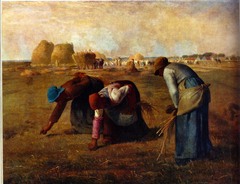
"The Gleaners" by Jean-Francois Milet 1857
Location
Style: Realism
There was some struggle between agrarian and industrialization unfolding in Europe. A gleaner is someone whose job is to clean the fields for the new harvest and to fallow. There was a new shift in industrialized farms because men left to get factory jobs to send money to their families. Women took part time jobs, such as being gleaners. All of the women's clothing looks the same in this painting, wearing dull Earth tones making them blend in. It reinforces that their individuality does not matter. They have strong bodies so we don't feel sorry for them because they're strong and monumental.
Shape: Triangles show their strength and stability, physically and emotionally.
Space: Show how much they have to clean; Men and women are separated.
Color/Hue: The women are dark and the background is dark which ties the women to nature. Like the sky and the Earth, they are unmoving and routine.
Diagonal line: gives a sense of movement= mechanized feeling since they're mass produced.
Texture: Reinforces the feeling that they're part of the Earth.
Napoleon at the Pesthouse at Jaffa, Antoine-Jean Gros, 1804.
Style: French Romanticism
This painting is a depiction of Napoleon as he asked to be shown. He wanted to be shown helping his plaque stricken troops but in reality he left them for dead. This is another example of using paintings to display historical events and important people.
Liberty Leading the People, Eugene Delacroix, 1830.
Style: Romanticism
This painting displays a woman in a war like scene as she embodies liberty , or a symbol of liberty. The ideal of liberty is what people tend to fight for during war time.
Women of Algiers in their Apartment, Eugene Delacroix, 1834.
Style: Romanticism
This painting depicts foreign women very differently than women have ever been portrayed before. The foreign ideals and differences are shown in the body language, clothing, housing, and the actions. The women are smoking opium and being depicted as less respectful of themselves than other women, they are shown below african people. This starts to show the oriental ideals in western society.
Watching a Sea of Fog, Caspar David Friedrich 1818.
Style: Romanticism
This displays the vast power nature has over man and how man can only look and observe it. Man is often compared along with nature. The mystery of the man's face brings about an ery feeling along with the upcoming fog. It makes the viewer wonder what hes looking at.
